HTC One S Review - International and T-Mobile
by Brian Klug on July 17, 2012 9:30 AM ESTCellular
The HTC One S includes Qualcomm’s MSM8260A SoC, which in turn corresponds to air interface support up to DC-HSPA+ Category 24 (two WCDMA carriers with 64QAM) for a max data rate of 42 Mbps. The difference between this and MSM8960 is obviously the lack of LTE, and lack of CDMA2000 1x/EVDO support which is in MSM8660A (but includes no DC-HSPA+). For T-Mobile, having another DC-HSPA+ phone is an obvious plus, and as we’ll show in a minute results in pretty impressive speeds. The previous DC-HSPA+ platform that T-Mobile deployed was the so-called “SoC Fusion” combination, which consisted of APQ8060 and MDM8220, in devices like the T-Mobile SGS2. International customers, I believe, will get DC-HSPA+ if their carrier has made the correct network and user provisions for it.
For those that aren’t familiar, DC-HSPA+ Category 24 (3GPP Rel.8) employs carrier aggregation in addition to the other HSPA+ features from Release 7. Essentially, two 5 MHz WCDMA carriers are aggregated together on the downlink, resulting in roughly double the performance of a single WCDMA carrier situation. Note that the uplink remains single carrier, so there’s even more of an asymmetry that happens, but given the traffic asymmetry that already exists for most mobile workloads this isn’t a huge deal. When you consider that most LTE deployments in the US are currently at maximum 10 MHz FDD, you can see the roots of T-Mobile’s DC-HSPA+ as “4G” argument. Of course, that is a vast oversimplification, as WCDMA and LTE differ massively in other fundamental ways such as multiplexing scheme (CDMA vs OFDMA) and other features (MIMO, flat IP PS, etc.).
The International and T-Mobile One S differ in what UMTS bands are supported, as the International One S targets both Asia and Europe, while the T-Mobile version goes for the Americas. I’ve made a table with the pertinent information.
| HTC One S - Network Support | |||||
| GSM/EDGE Support | 850 / 900 / 1800 / 1900 MHz | ||||
|
WCDMA Support One S - International |
850 / 900 / 2100 MHz | ||||
|
WCDMA Support One S - T-Mobile |
850 / 1700 / 1900 / 2100 MHz | ||||
| HSPA Speeds | HSDPA 42.2 (Cat.24) / HSUPA 5.76 (Cat.6) | ||||
| Baseband Hardware | Qualcomm MSM8260A | ||||
What’s awesome about the T-Mobile HTC One S is that it supports 2100 MHz UMTS Band I and AWS alongside Cellular 850 MHz and PCS 1900 MHz. The result is that if you either can find one unlocked, or unlock your T-Mobile One S, you get a quad-band phone which supports DC-HSPA+. I managed to get T-Mobile to unlock my One S, and had no issue using it on AT&T. If anything, I wish AT&T would carry a device like this, since I find the smaller form factor very appealing.
The transmit antenna for the One S is at the bottom in the plastic region, and up on the removable part is another diversity receive path.
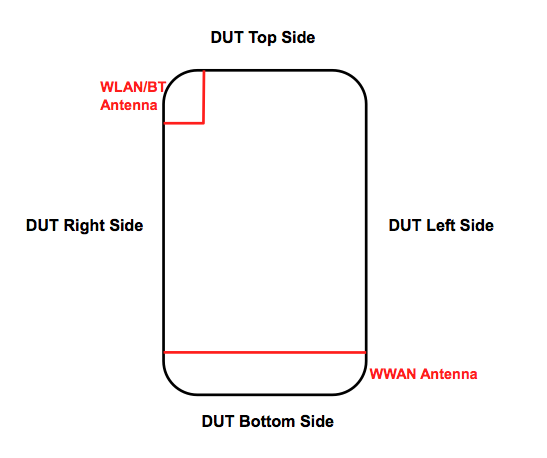
This is our second time showing some DC-HSPA+ results, the first time was in the T-Mobile SGS3. To test, I used the same workflow as always, essentially running as many tests as possible using Ookla’s speedtest.net application on Android, exporting the results, and making some pretty graphs with python.
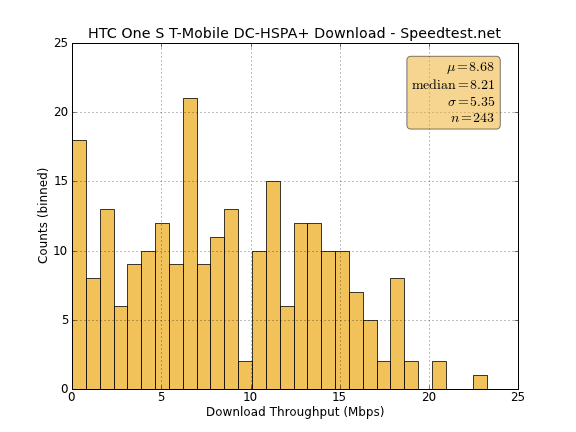
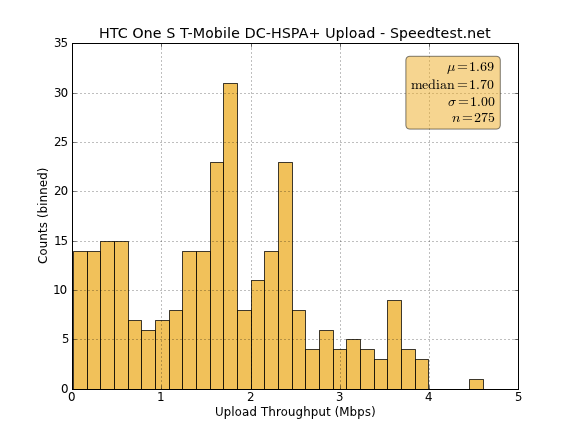
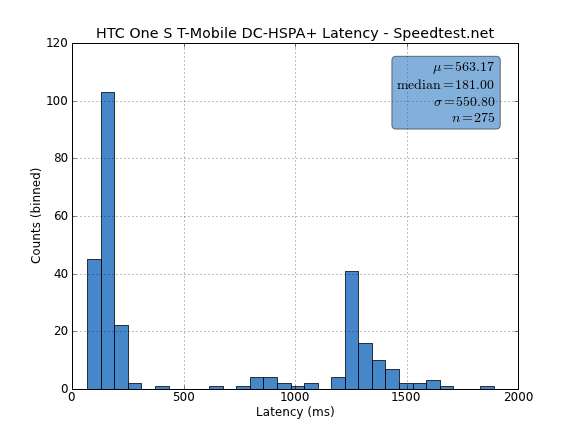
Unsurprisingly DC-HSPA+ is impressively fast on the downlink, with an average of around 9 Mbps and a maximum of just above 20 Mbps. It’s not the kind of performance you’ll get out of LTE (proving that the many subcarrier scheme employed in OFDMA and other enhancements to the physical layer in LTE does in fact pay off), but it’s pretty darn impressive nonetheless. There’s a weird double distribution in latency probably due to setup time coming out of CELL_PCH and setting up the DC-HSPA+ link. Running a test right after this setup yields much lower latency, which is why I say it seems to be connection setup related. I have to say that I’m impressed with how fast T-Mobile’s DC-HSPA+ is in my area, and that DC-HSPA+ isn’t a bad interim air interface until the carrier can deploy LTE. I have a lot of respect for how fast T-Mobile deploys WCDMA related updates.
On the international One S, my only option for testing was AT&T in an 850 MHz market in Pinal County north of me (I'm in Tucson, AZ from Pima county just south, where AT&T is only PCS 1900 MHz). I actually ended up driving over 400 miles and sleeping in a number of different hotel rooms (many Bothans died... and so forth) to finish battery life and speed testing on the International One S because it's the only county in Arizona where AT&T holds an 850 MHz license.
There the phone posted speeds that are more in line with what I expected for single carrier AT&T HSPA+. Running these was more of an exercise in making sure everything was working fine rather than proving something about the One S or AT&T. Those battery life numbers earlier on and seeing what experimental differences come from operating the Rx low noise amplifier in a 10 MHz wide configuration were the real effort. Note that the big power consumer, the Tx power amplifier, which is active when in CELL_DCH and CELL_FACH, is still just 5 MHz because DC-HSPA+ only affects the downlink.
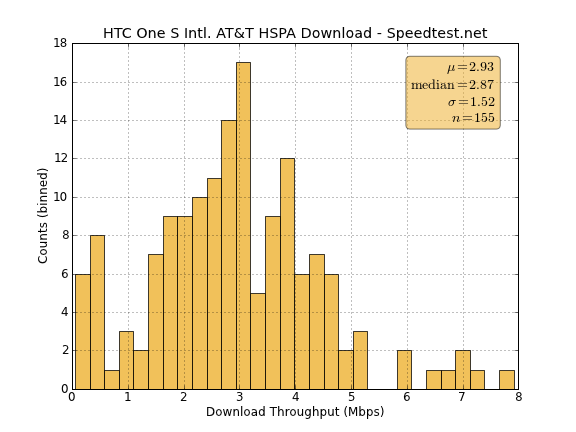

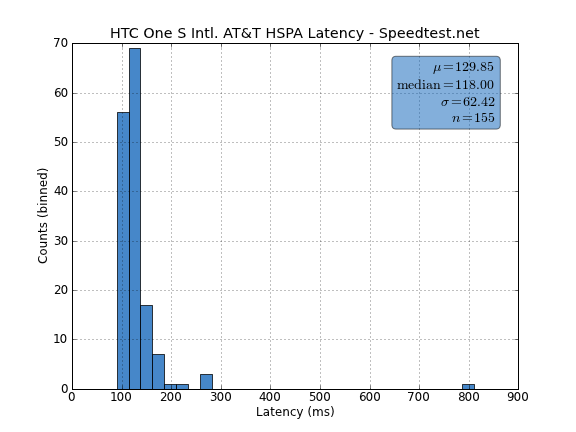
For Qualcomm, the MSM8260A is as much of a stepping stone as the MSM8960, as this is the first time DC-HSPA+ has been integrated into the on-SoC baseband. As I mentioned earlier, the previous solutions were APQ8060+MDM8220 or similar. For T-Mobile, having a number of phones coming up that are compatible with the network’s DC-HSPA+ network is critical to selling its service as being roughly on a similar footing as LTE.
WiFi
Like the HTC One X (AT&T) and XL, the HTC One S uses Qualcomm’s on-SoC baseband for WLAN and BT 4.0. Checking through the boot log, I see the same WCNSS firmware get loaded and initiated which is that WLAN+BT block. The difference between the One X/XL and One S WLAN is that the One S doesn’t include 5 GHz or 40 MHz channel support.
As noted in the above FCC schematic, the WLAN transmit antenna is up at the top in that removable plastic region.
One of our readers pinged me and let me know that reliable iperf ports are now available on Android and iOS, so I’ll be switching over to using iperf for my main WiFi throughput testing instead of the 100 MB PDF. I tested a small number of the phones I’ve got on hand with iperf for comparison.
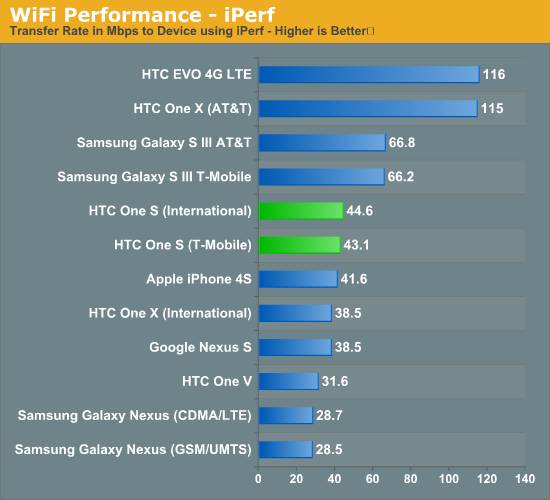
The One X and EVO both have 40HT support on 5 GHz, and thus pull pretty far into the lead. The 20 MHz channel 2.4 GHz devices cluster around 40 Mbps. Unsurprisingly the International and T-Mobile versions are very close.
Speakerphone
I tested speakerphone on the HTC One S using our sound meter 3 inches away from the device on maximum volume. The speakerphone on the One S is underneath the grid of holes on the back at the bottom plastic region. Interestingly enough the devices differed somewhat, though I’d attribute this more to the difference in carrier (AT&T on the International device) than any real difference in loudness between the two.
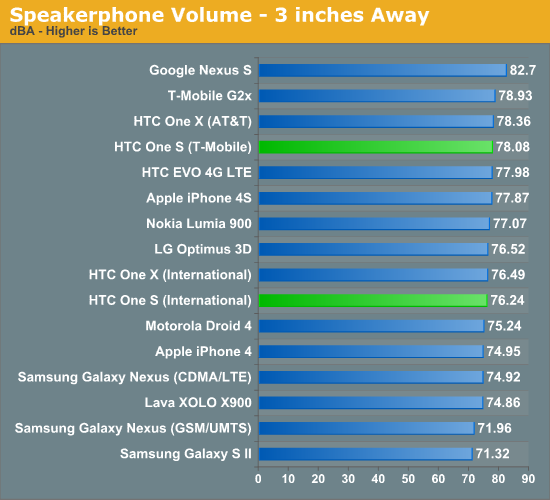
GNSS
I’m starting to sound like a broken record, but just like the One X (AT&T) the One S uses the on-SoC baseband for GNSS (Global Navigation Satellite System). In this case, that means GPS with GLONASS, specifically Qualcomm’s gpsOneGen 8A with GLONASS. I have no problems getting a fast lock even indoors or in an urban environment, and like other combos with GLONASS you can see those satellites pop into use when GPS signal is weak.


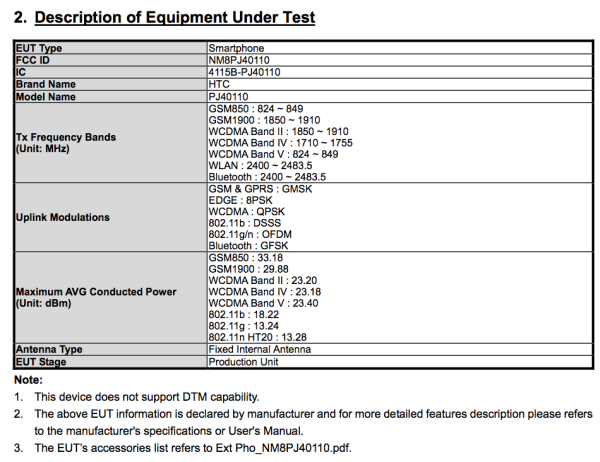
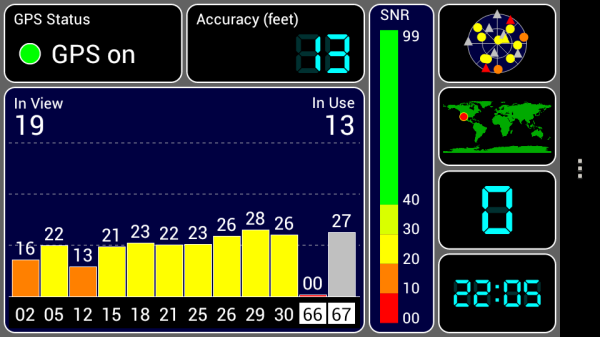








97 Comments
View All Comments
dgingeri - Tuesday, July 17, 2012 - link
as a One S owner for the last few months, I'm happy to say it's the best phone I've ever had. I'm thoroughly impressed with it. The only issues I have with it is that it's kind of hard to hold on to at times. I have dropped mine twice because the back surface is a bit slippery.I hadn't seen the cases, though. those look nice. I think I'll get one to offset that slippery back problem.
mgl888 - Tuesday, July 17, 2012 - link
Is there manual aperture control available for the camera? I don't see it in the GUI screen shots.Brian Klug - Tuesday, July 17, 2012 - link
No sadly, although no smartphones I'm aware of have variable apertures. Nokia gets closest by implementing an ND (neutral density) filter that attenuates light, but the aperture is fixed.-Brian
Zoomer - Thursday, July 19, 2012 - link
To be honest, the FOV difference is so small on the tiny lens.OCedHrt - Tuesday, July 17, 2012 - link
I've had a T-Mobile One S for about a month now and...1. I hate the USB port on the left - this makes the phone unusable as an incar GPS device because the USB cable is on the driver side.
2. Having just enough USB length for my previous phone with a USB port on the bottom, there just isn't enough left over reach with the USB port on the left.
3. Having the USB port just opposite of the volume buttons mean it's unavoidable you mess with the volume when plugging in the USB port with the screen on - such as when you're on the phone and try to plug it in only to find you've muted yourself.
4. HTC's marketing on this phone is very misleading - up until this article I did not know that T-Mobile's version did not have micro-arcing and I already have scuffs on metal back of the device.
5. The USB port also chips when trying to plug in the USB cable, as reported by many other owners. There is supposedly a revised version with a tapered USB port to fix this, but it seems not all carriers get it.
6. The power button on top is also not very accessible. As much as I prefer a HTC device over Samsung's, I still prefer power on one side with volume on the opposite. The usb power port on the bottom has not gotten in the way of me using the phone.
7. Finally, HTC seems to have silently swapped many One S's with higher clocked S3 instead of S4 due to shortages - this has created a bit of PR backlash in the affected markets.
Belard - Tuesday, July 17, 2012 - link
USB placement is never a perfect science... you are not holding it right :)Hence the only thing throwing me off of HTC phones is the power button on TOP and the vol rockers on the right side. Makes for 1 finger control I think. But for me and these HUGE phones, I didn't like. Samsung sticks its vol buttons on the left side, so they put their USB ports on the bottom, but they DID put them on the TOP for a while.
With this arrangement, thumb controls vol and index is more comfortable for the power.
For me, I think the top mounted USB makes a bit most sense, but doesn't look as good and in more danger of rain damage. With it on top, the phone can be oriented right when charging or is plugged into USB speakers. Mostly takes care of the GPS issue in the car... so top or bottom makes the most sense for a phone.
Again... thou, it still depends on the person.
PS: Hate rubber covers over the ports on phones, so its a fight to unplug those 1-3 times a day. Samsung used to use a plastic sliding door on the Galaxy S1.
OCedHrt - Wednesday, July 18, 2012 - link
It depends on how you use your phone. If you use your phone while it is plugged in, USB on top is also a bad idea. The only place where USB get's less in the way is on the side, or on the bottom. The problem with the left side is that is the driver side for most of us. This can be remedied by getting a car dock for the phone.Having buttons on the opposite side of the USB connector is also a bad idea, because you will push them while plugging in the cable.
The power button on top is okay, but it is hard to reach with one hand. For the Nexus S with the power on the right, and volume on the left, I never had any issues using the phone with one hand.
Reikon - Wednesday, July 18, 2012 - link
If your USB cable isn't long enough, just get a new one? They're like $3.And I've never had an issue pressing the volume buttons while plugging in USB. I've always held the phone on its bottom right (like how I normally hold the phone) while plugging in USB.
I do agree with the power button on the top being undesirable, though because being on top means it sometimes accidentally gets pressed while in my pocket, which brings me to another problem I have: the audio jack being on top.
I see no advantage to basically all phones having it on top. Having it on the bottom makes it so the cable doesn't potentially cover the screen and makes phones easier to pocket. When pocketing a phone directly from using it, you're naturally going to put it upside down, and headphones would get in the way for phones with the audio jack on top.
millerduck - Tuesday, July 17, 2012 - link
Massive problems with WiFi calling dropouts as well as poor performance in 1-2 bar cell areas. The HTC One S seems great in well-covered areas but on the edges it fails miserably. Other Android (MyTouch series) phones cope and can handle WiFi calling to supplement.On a network not known for consistent blanket coverage, this was the wrong handset!
MD
OCedHrt - Tuesday, July 17, 2012 - link
I have the same wifi problems - I've been trying to get it exchanged.And call static at times - not sure if correlated with signal yet.